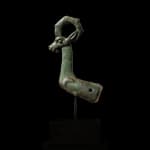Iran
A Luristan bronze whetstone handle, circa 9th - 7th century AD
Bronze
Height: 9.3 cm
In the form of a goat protome with short curved horns, the two front legs bent under the body, pierced for a pin to secure the cylindrical honing stone, now...
In the form of a goat protome with short curved horns, the two front legs bent under the body, pierced for a pin to secure the cylindrical honing stone, now broken.
Provenance
With Nicolas Koutoulakis (1910 - 1996), Paris and Geneva; thence by descentBelgian private collection, Brussels, acquired from the above circa 2017
Literature
The whetstone was used in order to sharpen edged weapons and tools. In Luristan, bronze whetstone sockets provided the opportunity for elaborate cast decoration, unlike anywhere else in the ancient Near East. Usually, whetstones were tools of the utmost simplicity, but the emergence of decorated sockets for ceremonial whetstones is documented from the late second millennium onwards.
Given the connection of whetstones with weapons used for battle and hunting, it can be assumed that zoomorphic handles bore, in addition to their decorative value, an apotropaic or magical value. This would have been considered to rub off, literally, onto the honed weapon.
Cf. P.R.S. Moorey, Ancient Persian Bronzes in the Adam Collection, London, 1974, pp. p.62, no. 33



